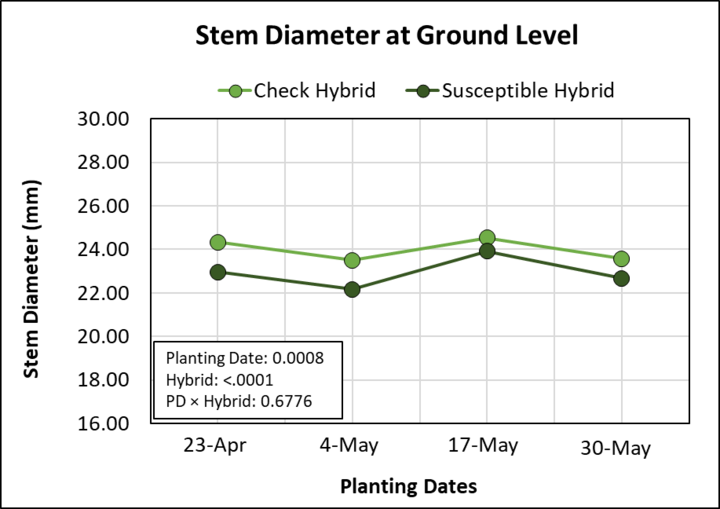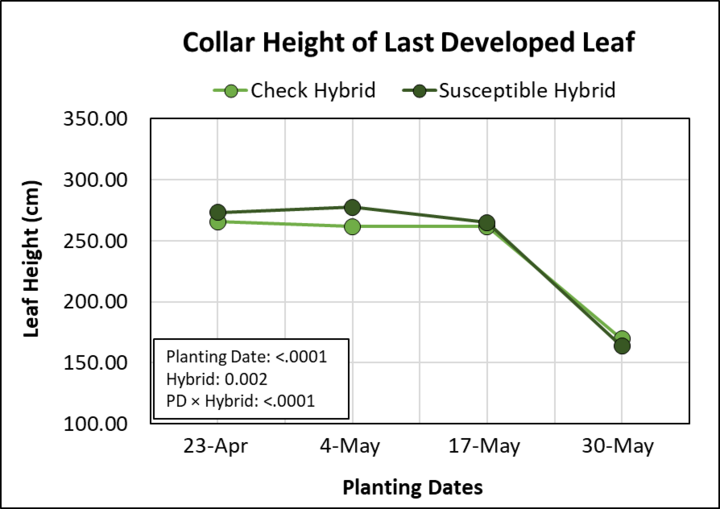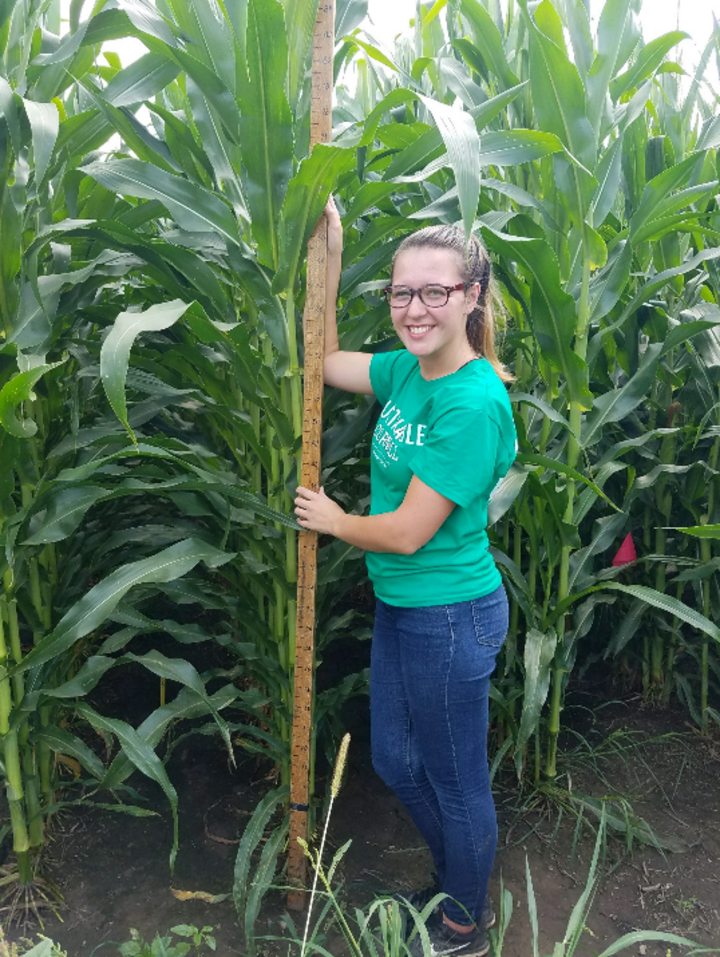Despite overall high-reported yields in 2016, there were reports of corn ear formation issues that ranged from Dawson to Saunders counties in Nebraska and at sites in Kansas, the Texas Panhandle, and eastern Colorado (Elmore et al., 2016 and McMechan et al., 2017). Uneven or delayed emergence of corn plants may be a factor. Differences in planting date, soil moisture, soil temperature, and seeding depth may result in delayed or uneven emergence. Secondary factors such as insect feeding, disease pressure, soil crusting, and herbicide injury can cause delayed emergence too.
Much literature has been published describing factors that affect corn ear development such as herbicides at V3-V4 stages (Cox et al., 2006), planting density (Sangoi, L., 2001), environmental conditions, insect damage, as well as many other biotic and abiotic factors. These factors often result in corn ear malformation and can result in significant decreases in yields. Three ear formation symptoms were consistently observed during the 2016 growing season:
- barbell/dumbbell shaped ears,
- short husk with normal ear length, and
- multiple ears per node.
The objective of this project was to see if delayed planting dates affected plant growth (leaf height, stem diameter, and internode length) and ear formation issues in corn.
Methodology
Location: The project was conducted under field conditions during the 2018 growing season at the South Central Agriculture Laboratory near Clay Center. The experiment was planted on a field previous cropped with soybeans. The research area was irrigated with a linear irrigation system as needed and base fertilizer was applied before planting.
Treatments. A susceptible (ear issues had been observed in the past) and a non-susceptible (control) hybrid were sown with about 12-day intervals over five weeks (April 23 - May 30) from the first sowing date. All plots were sown at 34,000 seeds per acre (83,980 seeds per ha).
Experimental Design. The experiment was arranged as a split-plot design with four replications. The main plot was planting date and the subplot, hybrid. Experimental plots consisted of four rows spaced at 30-inch intervals. Plots were 10 feet by 30 feet.
Plant Measurements. Beginning at corn growth stage V12 - 12th leaf (Abendroth et al., 2011), stem diameter at ground level (using digital calibers), height of last developed collar leaf (with a 9 foot ruler marked every 1 inch), and plant development stage was documented weekly up to the R1-silking stage. At the R2 stage (when internode elongation has normally stopped) internode length information was measured with a 9 foot ruler marked every 0.4 inch from bottom (ground level) to node 19.
Ear Issue Assessment. Occurred at early reproductive stage (R2-blister) in 10 previously marked plants.
Statistical Analysis. Data was collected for the collar height of the last developed leaf, stem diameter, and internode length and analyzed using SAS STUDIO (online service).
Results
Delayed Planting and Hybrid Effects on Stem Diameter

Effects of delayed planting and hybrid on stem diameter are shown in Figure 1. Planting date and hybrid impacted stem diameter. The second and fourth planting date had the smallest mean diameter out of the four dates. There was no difference between planting date one and three as well as planting dates one and four. On the hybrid side, there were differences between the diameters of the check and susceptible hybrids with check hybrid having larger diameters.
Delayed Planting Effect on Height of last Developed Leaf

There were hybrid and planting date effects on the collar height of the last developed leaf. Figure 2 shows the effects of planting dates and hybrids on leaf heights. For the check hybrid, the first three planting dates had similar heights, but there was a reduction in height for the last planting date. The effects of planting date for the susceptible hybrid were similar to the check hybrid in that the last date was significantly lower than the first three planting dates. By July-16 (when data in figure were collected), the first three planting dates showed similarities in leaf height despite a maximum of 24 days difference in planting times.
Delayed Planting Effect on Average Internode Length

Similar to leaf heights, there were hybrid and planting date effects on the average internode length. Figure 3 shows that both hybrids had similar trends with greater internode lengths observed for the last two planting dates. These results suggest that since late-emerged plants (last two planting dates) had longer internodes and either similar or shorter heights of the last collared leaf (Figure 2) compared to early-emerged plants (first two planting dates), node numbers were fewer with the later planted corn. Thus, internode expansion rates were likely more rapid with the later planting dates.
Delayed Planting Effect on Ear Formation Issues
Few ear issues were observed after assessment in plots and no trend between planting dates was identified. We assume that the 2018 growing season in the studied site did not have conditions that would result in ear formation issues in corn. Still we think that planting date is a relevant factor since ear development occurs at a sequence of key stages and environmental effects triggering ear issues must have different results when plants are at different stages when those events happen. Such results are understandable given the complex genotype, environment, and management (G × E × M) interaction that drives crop growth and development. Research efforts will continue in 2019 and 2020.
Conclusions
Stem diameter reductions occurred between the two hybrids but planting dates had little effect. Despite up to 24 days difference in planting times, leaf height of the first three planting dates were comparable by July 16. Shorter final leaf heights occurred with the latest planting date; however, upper-most leaf height was similar for both hybrids. Internode lengths for the last two planting dates were visibly longer than those of the first two planting dates. It is reasonable to assume that the plants in the last two planting dates allocated more of their resources to aboveground, rapid vertical growth.
Both hybrids had similar trends in internode length. Later planted corn had longer internodes, but did not reach the height of the earlier planted plants. We assume that fewer nodes were developed in the last planting time due to less time for growth but had more rapid internode elongation rates. Ear formation issues were assessed and almost no incidences were observed, except for a few plants with short husks (85% to 90% of full ear size properly covered). These issues were mainly associated with the susceptible hybrid and similarly present in all four planting dates.
Acknowledgment
This program was funded by USDA NIFA Agriculture and Food Research Initiative: Education and Literacy Initiative–Undergraduate Experiential Learning Fellowship Program. Partial support to this project was provided by Robert B. Daugherty Water for Food Global Institute (DWFI) at the University of Nebraska.
Special thanks to everyone at UNL who made Mrs. Farabaugh’s summer memorable.
About the Author

Kylee Farabaugh was one of nine undergraduate students completing an Integrated Agronomic Systems Fellowship at the University of Nebraska-Lincoln in summer 2018. She is pursuing her bachelor's degree at Cornell University.
References
Abendroth, L.J., Elmore, R.W., Boyer, M.J., Marlay, S.K. 2011. Corn Growth and Development.
Cox, W.J., R.R. Hahn, and P.J. Stachowski. 2006. Time of Weed Removal with Glyphosate Affects Corn Growth and Yield Components. Agronomy Journal 98(2): 349–353.
Elmore, R., Rees, J., McMechan, J., Jackson-Ziems, T., and Hoegemeyer, T. 2016. Corn ear formation issues likely correlated with the loss of the primary ear node. University of Nebraska Extension. CropWatch. 19 August, 2016.
McMechan, J., Elmore, R., Rees, J. 2017. Crop Production Clinics Proceedings.
Sangoi, L. 2001. Understanding Plant Density Effects on Maize Growth and Development: an Important Issue to Maximize Grain Yield. Ciência Rural 31 (1): 159–168.
Support References
Ciampitti, I.A. 2014. Abnormal Corn Ears. Kansas State University Agricultural Experiment Station and Cooperative Extension Service.
Strachan, S.D. 2004. Corn Grain Yield in Relation to Stress During Ear Development. Crop Insights Vol. 14, no. 1. Pioneer Hi-Bred, Johnston, Iowa.
